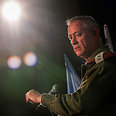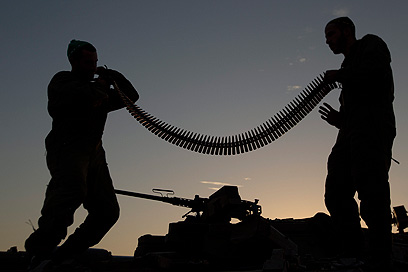
We'll pay heavy price if Gantz exaggerated
Analysis: IDF's multi-year plan may have severe repercussions, but change in operational outlook is critical
The IDF's new multi-year plan is being referred to as "bold," and it is exactly that. The Security Cabinet, which will be convened soon by the prime minister to discuss the plan, will not find it difficult to ascertain that those who formulated the work plan aimed at building the army's strength took unprecedented risks, bordering on unreasonable. What the public and media refuse to understand and internalize is that this time we are not talking about a typical ploy meant to frighten the Treasury into giving the army what it wants. This time, it seems, the heads of the army and security establishment are serious in their intention to implement the plan. Too serious, in my opinion.
The ministers who will be asked to approve the IDF work plan for the next five years should examine it carefully and make sure they understand its significance, because if the assumptions (on which the cutback plan is based) of IDF Chief of Staff Gantz, his deputy Gadi Eizenkot and the members of the General Staff are wrong, and if their evaluation of the army's abilities are wrong, then we're screwed. In two years' time we may find ourselves in a situation where the IDF, for weeks on end, is incapable of defeating the enemy while the home front sustains salvos of thousands of rockets on a daily basis - a situation that is similar to the Second Lebanon War but with much harsher results.
This does not pose an existential threat to the State of Israel, but the erosion on the front lines and in the home front could be significant. During the Second Lebanon War Israel achieved deterrence, but for 34 days we were unable to bring the fighting with Hezbollah to an end with a clear victory. One of the main reasons for this was the fact that the war erupted as the IDF was implementing extensive reforms in its structure and operational outlook.
I am not suggesting this is what will necessarily happen if the current plan (which includes, among other things, shutting down Air Force squadrons and armored units) is implemented, but the danger exists. It should be noted that the plan will most likely lead, in a few years, to an improvement in the IDF's ability to win wars quickly – even if they are fought on two or three fronts.
The "bold" plan is also expected to save a lot of money, but for this to occur four conditions must exist:
1) The circumstances in the neighboring countries and in Iran will not force the IDF to deal in the near future with a surprise attack by an army or armies (we must take into account that this scenario is possible even under the current conditions in Egypt and Syria).
2) The government must make good on its commitment to funnel to the IDF funds that will increase gradually from 2015 and onwards. The government has already approved this in principle, but it must be implemented.
3) Defense Minister Ya'alon, IDF Chief Gantz and the General Staff must personally see to it that while the reforms are carried out the army will continue to maintain the current level of preparedness of the combat units.
4) Washington will once again assist Israel in funding a critical amount of batteries to intercept rockets, as well as a large supply of intercepting missiles of all kinds. There isn't enough money in being "bold" to build an active and effective multi-layered air-defense system.

Second Lebanon War all over again? (Archive photo: AP)
If these conditions are satisfied at a reasonable level of implementation, in four years or so the State of Israel will have a thin but modern and lethal army; an army that is capable of deterring an enemy from fighting us; provides maneuverability to heads of state and can win a war quickly if and when it breaks out. If the government does not plan on meeting these conditions, the planned IDF reform will not be carried out, because the army, in light of the budget cut, will have less and less of its old and soon-to-be obsolete strength components, while the compensation in the form of higher quality will arrive only later.
Higher quality means the purchase in large amounts of accurate weaponry, the speedy development of new cyber and intelligence capabilities and the upgrading of the Navy from a coast guard to a combat unit that affects the fighting on the land. The transition period, which is due to begin in two years, will be critical, among other things because the decrease in the number of units may chip away at the army's deterrence in the face of nearby enemies (Hezbollah, for example) or far off ones (Iran).
But the most important component of the "bold" plan is not the reduction in the number of army units or the higher quality weaponry. The brilliance of the plan is that it incorporates the army's new operational outlook, which is based on the principle of employing all of the army's force and branches simultaneously in the face of the challenges in the various arenas. This change is necessary because the cutback in combat units and platforms (tanks, warplanes and battleships) will lead to a situation whereby one command or one branch will not be able to deal independently with numerous and complex tasks in their respective sectors. This situation will obligate the IDF, on all its branches and abilities, to act in order to defeat the enemy on the front where most of the efforts will be concentrated and block the enemy in the rest of the sectors.
In other words, Armored Corps and infantry units will cooperate with the Air Force and Navy to curb the rocket fire on the home front. Fighter jets and Navy vessels will deal with the modern Russian missiles, and so forth and so on. To achieve this, the army must be flexible and fast in its transition from mission to mission. The main thing is not to waste precious time and money on statistical fire. Each missile, which costs hundreds of thousands of dollars, must be directed at a target that is spread on no more than one or two meters. The Intelligence Branch, which has undergone a dramatic revolution over the past few years, already provides thousands of such targets to the fighting and firing forces. It is also capable of producing targets during the fighting itself.
In order to implement this operational outlook the IDF must change the basic geographical arrangement of its divisions in a way that will allow them to act quickly according to the operational plans. The General Staff will have at its disposal a large iron fist on land which it will be able to activate, fully or partially, in favor of what will be considered the main effort.
Operations deep in enemy territory will also possible, though it's a shame that equipping armored divisions with defense systems for tanks is not high on the army's list of priorities. These systems save lives and allow the armored forces to quickly crush enemies who use advanced anti-tank missiles – be they Hezbollah in Lebanon or Jabhat al-Nusra in Syria.
The IDF plan is very bold and creative. Now comes the critical moment in which the cabinet ministers and Treasury officials determine the fate of this revolutionary plan and its chances for success.










